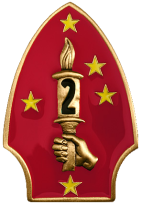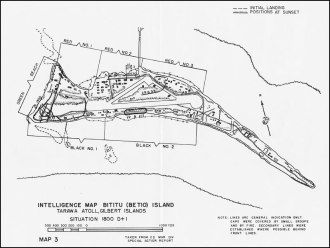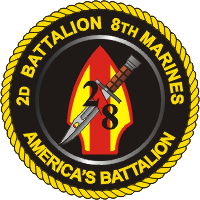There are quite a number of famous people who have served as United States Marines. The list includes Hollywood actors, sons of presidents, athletes, politicians, musicians, and astronauts. A number of Marines have become legends —I have written about several here— some of those in their own time … and some, perhaps, in their own mind. I personally enjoyed researching “Handsome Jack” Myers, who was the real deal “Old Corps” Leatherneck. I would have enjoyed listening to him recount some of his adventures.
I recently uncovered another interesting old breed (pre-World War II) Marine. I can’t say that his career was extraordinary because his was a professional pattern shared with many other Marines. But what makes this fellow stand out is that he was a bona fide hero of the Battle of Tarawa. I am astonished that more people do not even know his name.
Before we get to that, however, let me offer a summary of what happened at Tarawa —and why.
 Tarawa is an atoll in the central Pacific Ocean, part of the Gilbert’s Islands and now part of the Republic of Kirbati. A wide reef and a large lagoon of over 500 square kilometers characterize the atoll. The battle fought there lasted four days (20 November to 24 November 1943), and it was one of the bloodiest campaigns in Marine Corps history. The code name for the engagement was Operation Galvanic. It involved the 2nd Marine Division and its subordinate regiments: 2nd Marines, 6th Marines, 8th Marines, and 10th Marines and the target of the Marine’s attentions was the island named Betio.
Tarawa is an atoll in the central Pacific Ocean, part of the Gilbert’s Islands and now part of the Republic of Kirbati. A wide reef and a large lagoon of over 500 square kilometers characterize the atoll. The battle fought there lasted four days (20 November to 24 November 1943), and it was one of the bloodiest campaigns in Marine Corps history. The code name for the engagement was Operation Galvanic. It involved the 2nd Marine Division and its subordinate regiments: 2nd Marines, 6th Marines, 8th Marines, and 10th Marines and the target of the Marine’s attentions was the island named Betio.
Betio Island is located about 2,400 miles southwest of Pearl Harbor, Hawaii; it is the largest island within the Tarawa Atoll. It is two miles long and about 800 yards wide at its widest point. Before Japan’s attack on Pearl Harbor in December 1941, Tarawa Atoll was a British Commonwealth territory; it was the British who constructed the unusually long pier along the north shore into the lagoon. After Pearl Harbor, the Japanese seized Tarawa and executed its occidental occupants. The northern coast of Betio Island faces into the lagoon, while the southern and western shore face the deep waters of the open ocean.
After the end of the Solomon Islands campaign (Battle for Guadalcanal in the Southern Pacific), Washington military planners decided that it was time to begin an offensive into the Central Pacific region. The strategy was to capture Japanese held islands, establish advanced air bases, and use these bases as stepping-stones to move the US military ever closer to the Philippines and the main islands of Japan. They called it island hopping and it was a strategy that made sense.
 Tarawa Atoll became the first step in the so-called island hopping campaign —a strategy devised to offset the fact that the United States had a limited number of aircraft carriers in the Pacific. Advanced air bases would allow the United States to move across the Central Pacific toward the Philippines and Japan. But, before that could happen, the US needed to capture the Mariana’s Islands. Before they could do that, the US had to seize the Marshall Islands. They could not take the Marshall Islands until the first pacified the Gilbert Islands … which brings us to the Tarawa Atoll. The enemy garrison and airfield at Betio interfered with US intentions and so it became necessary to remove them.
Tarawa Atoll became the first step in the so-called island hopping campaign —a strategy devised to offset the fact that the United States had a limited number of aircraft carriers in the Pacific. Advanced air bases would allow the United States to move across the Central Pacific toward the Philippines and Japan. But, before that could happen, the US needed to capture the Mariana’s Islands. Before they could do that, the US had to seize the Marshall Islands. They could not take the Marshall Islands until the first pacified the Gilbert Islands … which brings us to the Tarawa Atoll. The enemy garrison and airfield at Betio interfered with US intentions and so it became necessary to remove them.
The Japanese garrison consisted of about 4,700 Imperial troops; half of these were members of the 7th Sasebo Special Naval Landing Force (Japanese Marines) —and they weren’t known for running away from a fight. Also present were men of the 111th Pioneer Battalion (similar to Seabees), the 4th Fleet Construction Battalion, the 3rd Special Base Defense Force, all of who were commanded by Admiral Keiji Shibazaki and Commander Takeo Sugai. Their mission was to inflict as much damage upon the American military as possible. They did their best.
Betio Island was the first time the U. S. Marines conducted an amphibious assault against a heavily defended, well-fortified objective. There were many hard lessons learned at Tarawa and the cost of these lessons was very high. Still, there was no way around it; either these lessons had to be learned at Tarawa, or they would have to be learned at some other location. They involved how to load ships for amphibious operations (last on, first off), important lessons about naval preparatory fires, and vital lessons about close air support. The Marines learned about tides.
A submerged reef surrounded Betio Island approximately 500 yards into the lagoon, which was the reason why the British constructed such a long pier in the island’s center. British experts [1] that had direct knowledge of the atoll informed the Marines that the tide tables used to plan the operation were notoriously inaccurate. These tide tables suggested that the Marines could expect five feet of water over the surrounding reefs at neap tide —high enough to get landing boats from the deep-water lagoon into the beach. They did not take into account the dodging tides [2]. The submerged reef and the irresolute tides restricted the continuous movement of troops, supplies, and equipment from ship to shore. Beyond this, naval preparatory fires were poorly executed and inadequate; air support was ineffective. These were some reasons the fighting was so desperate, why there were so many Marine casualties, and why the battle lasted 72 grueling hours. The ordeal that unfolded here caused ordinary men to perform extraordinary feats.
His name was Henry Pierson Crowe. He was born into an average family in Boston, Kentucky in 1899. He left school before graduation to join the Marine Corps in 1918. Serving briefly in France, he was discharged from the Marine Corps in 1919; three years later, he reenlisted. He spent the 1920s on expeditionary duty in the Dominican Republic and Nicaragua, and he also participated in national shooting competition. He was awarded the Distinguished Marksman Medal in 1927.
The Marine Corps appointed Crowe to Marine Gunner in 1934 —a warrant officer designation aimed at promoting to junior officer grades certain enlisted Marines with specialized knowledge and skill. From 1936 to 1939, Crowe served at the United States Embassy in Peiping, China. He was subsequently assigned to the 6th Marine Regiment, and the 8th Marine Regiment. He was promoted to Chief Master Gunner in February 1941.
Following the Japanese attack at Pearl Harbor in December, the 8th Marines embarked to Samoa in the following month. Crowe received a commission to Captain in February 1942 and assumed command of Weapons Company, 8th Marines. On Guadalcanal, Captain Crowe’s heroism under fire earned him both the Silver Star and Bronze Star medals.
After the Solomon Islands campaign, the 2nd Marine Division was withdrawn to New Zealand for rest, replacements, refitting, and further training. Captain Crowe was promoted to Major in March 1943 and assigned to command the 2nd Battalion, 8th Marines (2/8).
The initial assault force at Betio Island consisted of the 2nd Battalion, 2nd Marines (2/2) (Landing designation Red 2) Commanded by LtCol Herbert R. Amery, Jr., the 3rd Battalion, 2nd Marines (3/2) (Red 1), Commanded by Major John F. Schoettel, and Crowe’s 2/8 (Red 3). The 1st Battalion, 2nd Marines would be held in reserve.
The landing force began debarkation into assault vehicles at 0320 on 20 November 1943. Things started going wrong almost immediately; troop transports were lined up incorrectly, amphibian vehicles weren’t sure where they were supposed to be during the loading phase, rough sea made cross-deck loading dangerous and slow, and carrier support was delayed by more than 30-minutes. When air support did arrive, it was ineffective. Through all this chaos, Marines designated for the amphibious assault remained in the lagoon, bobbing up and down in their amphibian vehicles and landing craft for more than five hours.
 The Marines began heading for Betio Island at 0917 hours. The first wave slammed in to the reef, crawled over it, and headed to the shoreline … and that’s where everything came to a painful, devastating halt. Well-directed defensive fires cut into the Marines; the assault faltered when senior leaders were killed, and entire platoons were wiped out. There was no way the first wave could make it beyond a small log-abutted seawall. A Japanese officer was seen standing atop a concrete bunker waving to the Marines with his pistol, “Come on … come on.” As additional waves of Marines headed toward Betio, the tiny beachhead, if that’s what you could call it, began piling up with dead and wounded Marines.
The Marines began heading for Betio Island at 0917 hours. The first wave slammed in to the reef, crawled over it, and headed to the shoreline … and that’s where everything came to a painful, devastating halt. Well-directed defensive fires cut into the Marines; the assault faltered when senior leaders were killed, and entire platoons were wiped out. There was no way the first wave could make it beyond a small log-abutted seawall. A Japanese officer was seen standing atop a concrete bunker waving to the Marines with his pistol, “Come on … come on.” As additional waves of Marines headed toward Betio, the tiny beachhead, if that’s what you could call it, began piling up with dead and wounded Marines.
Then the dodge tide took horrendous effect; as landing craft ground to a halt on the reefs 500 yards off shore, Marines began to abandon them, crawled over the side, and began wading ashore into intense machine gun fire directed at them by the Japanese. Not many made it, but one that did was Major Jim Crowe. When his landing craft impaled itself on the submerged reef, Crowe shouted “Damn it to hell! Alright Marines … follow me.” Over the side he went. 2/8’s commander arrived on the hostile shore within scant moments of the first wave.
The battle was not shaping up very well. It was so bad that Division Commander decided to commit his reserve forces after only one hour.
Holding the American beachhead on Betio Island rested in good measure with fiery, redheaded mustang commander of 2nd Battalion, 8th Marines, Henry P. Crowe. There were a couple of reasons for this. Most of 2/8 landed in organized formation and without sustaining massive casualties. In contrast, 2/2 and 3/2 both sustained a considerable number of killed and wounded, including Colonel Amey. The commander of troops ashore, Colonel David M. Shoup [3], turned to Major Crowe to become the crutch upon which the landing operation could proceed. Shoup needed Crowe to not only maintain his position on Red 3 —he needed him to expand it. But the Japanese were now paying attention to Major Crowe’s battalion and 2/8 started taking heavy casualties, too. As Marines waded ashore from left of the pier into Major Crowe’s section of the beach, he plugged them in to 2/8 units as replacements for the killed and injured. Throughout this horrific battle, Major Crowe was a tower of strength. One must wonder how many Marines were saved from certain death by Major Crowe’s calm demeanor and his command presence under the most adverse conditions.
Today there is a diorama depicting the Battle of Tarawa, and Major Crowe, at the National Museum of the Marine Corps.
The slugfest continued for four days. Ultimately, the Japanese were overwhelmed —and while they were willing to fight to the death, they soon became too tired, too thirsty, and too disorganized to continue a coordinated defense. Yes, they did have courage and determination, but it was no substitute for cohesive action, and there is no stopping American Marines, no matter how many casualties it takes, from achieving their combat objectives. Marine casualties included 1,696 killed in action; 2,101 wounded in action. Only 17 Japanese Marines were taken alive.
For his extraordinary leadership at Tarawa, Major Crowe received the Navy Cross.
 Major Crowe also participated in the Battle of Saipan; his entire World War II service was with the 8th Marine regiment. After the war, LtCol Crowe served with the 29th Marines in China, and after returning to the United States, completed professional military education appropriate to his rank.
Major Crowe also participated in the Battle of Saipan; his entire World War II service was with the 8th Marine regiment. After the war, LtCol Crowe served with the 29th Marines in China, and after returning to the United States, completed professional military education appropriate to his rank.
Returning once more to California, LtCol Crowe served as a battalion executive officer and, while at Camp Pendleton, California, along with Colonel David M. Shoup, 1st Lieutenant Harold Schrier, Rene Gagnon, Ira Hayes, and John Bradley appeared in a cameo role as himself in the John Wayne film Sands of Iwo Jima.
In 1950, Crowe was dispatched to Japan and assumed command of the 1st Shore Party Battalion and participated in the amphibious landing at Inchon, the Inchon-Seoul Campaign, and the landing at Wonsan.
Promoted to Colonel in 1951, Crowe served at the Amphibious Training Command at Coronado, California, commanded H&S Battalion at MCRD San Diego, and additionally served as the Marine Corps technical advisor in the making of the film Battle Cry—a story written by former Marine Leon Uris, who during World War II served in the 6th Marines.
Having completed 41 years of active service, Colonel Crowe retired from active duty on 1 March 1960. Subsequent to his retirement, he served as the Chief of Police in Portsmouth, Virginia until 1969. Colonel Crowe passed away on 27 June 1991 at the age of 92. Colonel Crowe’s personal decorations include the Navy Cross, Silver Star, Legion of Merit with combat “V” device, Bronze Star Medal (three awards), with combat “V” device, and the Purple Heart Medal (two awards).
We must not forget such men as these.
____________
Notes:
[1] Major F. L. G. Holland, Royal Army and Captain Warnham, Royal Navy
[2] Dodge tide is a term for a neap tide with minimal rise and fall over the course of a day or two.
[3] 22nd Commandant of the Marine Corps
[4] It was my privilege and honor to serve in Company E, 2/8 from 1963 to 1964.

I just happen to be in the middle of “Utmost Savagery” by Col. Alexander about Tarawa. So many people know only about Guadalcanal, Iwo Jima and possibly Okinawa, but there were so many other islands that need recognition for the lives they cost. Great post!
LikeLike
Greatness! Thanks for remembering and sharing about this American hero!
LikeLike
It is impossible to imagine assaulting such a heavily defended shore. The amazing thing is that even more Marines didn’t fall … damn. As horrific as the battle was, it is part of what most people think about the Marines—it even affects how Marines see themselves: the best fighting force on the planet. You have to know that God loves His Marines.
LikeLike
I had read somewhere the two Japanese commanders were killed by artillery fire sometime around or after the landings, thereby adding to the demise of the Japanese forces? Like a chicken without its head? I am curious to learn from the expert.
Your accounting of the battle was humbling. Totally humbling. You read or see of the generalities in documentaries or in short stories, but I have never read of the battle in such depth. Five hours making donuts in the ocean? Geez…
You must feel some deserving kinship to this mustang, sir… and his combat history is remarkably overlooked as you reported. I don’t know how many times I’ve watched “Sands of Iwo Jima” and while recognizing the three surviving flag raisers, I did not know at all it was not only representing a great Marine but of Colonel Crowe. I’ve always viewed the movie as highlighting the guys in the sand and not the officers, per se. The “log pier” scene was one that sticks in my mind…
It always saddens me to read that after all that training and drills, some boys never had a chance to show their true grit, being unable to make it to the sands.
LikeLike
It was the mustache.
[;-)
LikeLike
Pretty wild, huh?
LikeLike